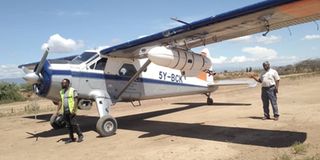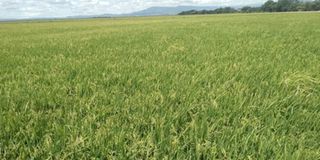Tanzania destroys 50m quelea birds, saves 500,000 tonnes of crops

A special aircraft from the Desert Locust Control Organisation for Eastern Africa (DLCO-EA) was deployed to eliminate destructive quelea birds in the fields across the country. PHOTO | COURTESY
What you need to know:
- He said that despite an upsurge in the migratory, crop-devouring birds, the organisation, operating under the Ministry of Agriculture alongside TPHPA, had continued to respond effectively, noting that control efforts were still ongoing in the affected areas.
Mbeya. The Desert Locust Control Organisation for Eastern Africa (DLCO-EA), in collaboration with the Tanzania Plant Health and Pesticides Authority (TPHPA), has killed over 50 million quelea birds, saving an estimated 500,000 tonnes of crops that would otherwise have been destroyed.
The Desert Locust and Migratory Pests Situation Report issued in March 2025 shows threats of a red-billed quelea bird in Manyara, Shinyanga, Tabora, Mbeya, and Dodoma regions.
In response, aerial control operations were launched from 16 March 2025 in Manyara and Dodoma, an estimated 16 million birds were controlled over 467 hectares using 887 litres of Bathion 60 percent ULV.
In December 2024, quelea control operations continued in the Mwanga and Moshi districts of the Kilimanjaro Region.
Twelve 12 sites were sprayed with 525 litres of Bathion 60 percent ULV to manage an estimated population of 31 million birds.
DLCO-EA manager, Mr Didas Moshi, told The Citizen recently that the three-month operation covered more than 50,000 acres across the Shinyanga, Singida, Dodoma, Manyara, and Mbeya regions.
The move has brought relief to farmers growing rice, finger millet, sorghum, and bulrush millet.
He said the infestation had been particularly severe, with birds migrating into Tanzania from neighbouring countries.
He said that despite an upsurge in the migratory, crop-devouring birds, the organisation, operating under the Ministry of Agriculture alongside TPHPA, had continued to respond effectively, noting that control efforts were still ongoing in the affected areas.
“In Mbeya, the birds are damaging rice fields, similar to the situation in Shinyanga and Tabora. In central regions like Singida, they’re targeting bulrush millet, sorghum, and finger millet,” said Mr Moshi.
“Our operation has covered over 50,000 acres and saved 500,000 tonnes of food crop farms,” he said.

Rice fields at Kapunga Farm in Mbarali District, Mbeya Region. PHOTO | COURTESY
He noted that one of the biggest challenges was the birds’ movement across borders, but the agency remained prepared to tackle the threat in partnership with TPHPA.
“Our aircraft for aerial control is already in Mbeya. We’ve started in Madibira and will continue to Kapunga. Our focus is on controlling all migratory pests that move across borders,” he added.
TPHPA manager at the Southern Highlands Zone, Mr Pius Kawala, said the authorities identified bird breeding and roosting areas through investigation, and the birds are being eradicated using the Quelea Tox.
He said the government is working to acquire its aircraft to improve operations, as it currently relies on hired planes from Ethiopia.
“We ask farmers and the public to continue trusting the government. We are committed to working together to promote quality agricultural practices and increase yields,” Mr Kawala said.
DLCO-EA pilot Eutychos Ruigu hinted that unfavourable weather conditions remained a major challenge in the undertaking of their activities.
“We work based on guidance from TPHPA. The biggest issue is the weather. We target the birds in their roosting sites, operating early in the morning and again at dusk,” he explained.
A farmer, Mr David Mkeya, expressed gratitude to the government for the support provided by DLCO-EA and TPHPA.
“These birds appear suddenly, especially when the rice is at the milk stage, and we fear huge losses after investing so much,” said Mr Mkeya.
“We appreciate the government’s efforts, especially by the Ministry of Agriculture. DLCO-EA and TPHPA responded quickly and established operations on-site. That gives us hope.”



